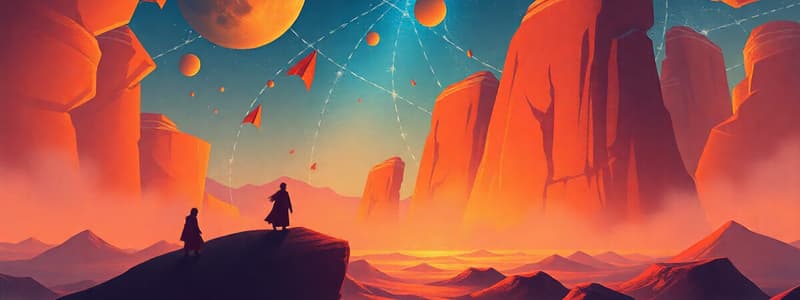Podcast
Questions and Answers
What is the definition of media literacy?
What is the definition of media literacy?
The ability to access, analyze, evaluate, and communicate media content.
What are the key elements of media consumption habits for young people?
What are the key elements of media consumption habits for young people?
Young people spend an average of 6.5 hours daily on media, including TV, music, the internet, and video games. They have increased access to media due to mobile devices, social media, and streaming platforms. However, despite high media consumption, engagement with physical activities and family time is limited.
Which of the following are types of literacy related to media?
Which of the following are types of literacy related to media?
- Digital Literacy (correct)
- Multicultural Literacy (correct)
- Emerging Technology Literacy (correct)
- Information Literacy (correct)
What are the main differences between traditional and new media?
What are the main differences between traditional and new media?
Which of the following are considered challenges of new media?
Which of the following are considered challenges of new media?
What is the Internet of Things (IoT)?
What is the Internet of Things (IoT)?
How does IoT impact new media?
How does IoT impact new media?
How can businesses utilize IoT data?
How can businesses utilize IoT data?
What is the connection between IoT and big data?
What is the connection between IoT and big data?
What are the basic concepts of IoT?
What are the basic concepts of IoT?
Which of the following are key skills needed for IoT users?
Which of the following are key skills needed for IoT users?
How does the convergence of technologies contribute to the advancement of the IoT?
How does the convergence of technologies contribute to the advancement of the IoT?
Which of the following are real-world applications of IoT?
Which of the following are real-world applications of IoT?
What are the security and privacy challenges associated with IoT?
What are the security and privacy challenges associated with IoT?
What are the key components of IoT systems?
What are the key components of IoT systems?
Which of the following are communication technologies used in IoT?
Which of the following are communication technologies used in IoT?
How do cloud computing and IoT work together?
How do cloud computing and IoT work together?
What are some real-world examples of how big data is used in IoT?
What are some real-world examples of how big data is used in IoT?
What are the challenges associated with managing big data in IoT?
What are the challenges associated with managing big data in IoT?
What is big data, and where does it originate?
What is big data, and where does it originate?
Which processing models are used for big data?
Which processing models are used for big data?
What are the key takeaways from the chapters on new media, IoT, cloud computing, and big data?
What are the key takeaways from the chapters on new media, IoT, cloud computing, and big data?
Flashcards
Media Literacy
Media Literacy
The ability to access, analyze, evaluate, and communicate media content.
Media Consumption Habits
Media Consumption Habits
Patterns of how often and in what ways individuals engage with media.
Digital Literacy
Digital Literacy
The ability to use digital tools effectively.
Information Literacy
Information Literacy
Signup and view all the flashcards
Multicultural Literacy
Multicultural Literacy
Signup and view all the flashcards
Emerging Technology Literacy
Emerging Technology Literacy
Signup and view all the flashcards
Traditional Media
Traditional Media
Signup and view all the flashcards
New Media
New Media
Signup and view all the flashcards
Misinformation
Misinformation
Signup and view all the flashcards
Social Isolation
Social Isolation
Signup and view all the flashcards
Privacy Issues
Privacy Issues
Signup and view all the flashcards
IoT (Internet of Things)
IoT (Internet of Things)
Signup and view all the flashcards
Smart Devices
Smart Devices
Signup and view all the flashcards
Hyper-Personalized Content
Hyper-Personalized Content
Signup and view all the flashcards
Predictive Analysis
Predictive Analysis
Signup and view all the flashcards
Cloud Computing
Cloud Computing
Signup and view all the flashcards
Big Data
Big Data
Signup and view all the flashcards
Real-Time Analytics
Real-Time Analytics
Signup and view all the flashcards
Embedded Systems
Embedded Systems
Signup and view all the flashcards
Communication Technologies
Communication Technologies
Signup and view all the flashcards
Microcontrollers
Microcontrollers
Signup and view all the flashcards
Sensor
Sensor
Signup and view all the flashcards
Security Challenges in IoT
Security Challenges in IoT
Signup and view all the flashcards
AI in IoT
AI in IoT
Signup and view all the flashcards
5G Networks
5G Networks
Signup and view all the flashcards
Machine Learning
Machine Learning
Signup and view all the flashcards
Smart Homes
Smart Homes
Signup and view all the flashcards
Health Monitoring
Health Monitoring
Signup and view all the flashcards
Industrial IoT
Industrial IoT
Signup and view all the flashcards
Data Management Challenges
Data Management Challenges
Signup and view all the flashcards
Study Notes
Chapter 1: Introduction to New Media Literacy
- New media literacy is the ability to access, analyze, evaluate, and communicate media content.
- It helps individuals understand media messages critically.
- Young people spend an average of 6.5 hours daily on media (TV, music, internet, video games).
- Increased access to media is due to mobile devices, social media, and streaming platforms.
- Media consumption often limits engagement in physical activities and family time.
- Digital literacy involves using digital tools effectively.
- Information literacy requires identifying, evaluating, and using information efficiently.
- Multicultural literacy involves understanding cultural differences in communication.
- Emerging technology literacy means adapting to new technologies and innovations.
- Traditional media includes newspapers, TV, radio, and magazines.
- New media includes social media, blogs, mobile apps, and interactive websites.
- Digital media is growing faster due to ease of access.
- Challenges of new media include misinformation and fake news, social isolation, and privacy issues concerning data collection.
Chapter 2: Internet of Things (IoT) - The Future of New Media
- IoT refers to everyday objects embedded with sensors, software, and internet connectivity.
- Devices collect and exchange data, automating processes without human intervention.
- Smart devices (TVs, wearables, voice assistants) impact media consumption with personalized content.
- IoT allows for hyper-personalized content (e.g., Spotify recommendations, Netflix algorithms).
- Businesses use IoT-generated data to predict consumer behavior.
- IoT generates massive amounts of data, analyzed for insights, improving services using AI and machine learning.
- Examples: Smart fridges suggesting grocery orders based on usage patterns.
Chapter 3: Introduction to Internet of Things (IoT)
- IoT devices consist of sensors, actuators, and connectivity modules.
- Devices automatically sense their environment and trigger actions.
- Key skills for IoT users involve:
- Hardware development (e.g., Arduino, Raspberry Pi)
- Networking (Wi-Fi, Bluetooth, Zigbee, RFID)
- Application development
- Security & Privacy
- Machine Learning/AI analysis of IoT data
- IoT is evolving due to faster internet speeds, AI, and cloud computing..
- 5G networks will further enhance IoT capabilities.
- Businesses use IoT to increase efficiency, reduce costs, and improve decision-making.
- Real-world applications include smart homes, healthcare (remote patient monitoring), and industrial IoT (machine failure detection).
Chapter 4: Technologies Behind IoT
- Embedded Systems: Small computers built into devices (e.g., smart thermostats, automated vehicles)
- IoT Hardware: Microcontrollers (e.g., Arduino, Raspberry Pi) and Sensors (motion, temperature, GPS).
- IoT Software: RIOT OS, Thingsquare Mist
- Communication Technologies: Wi-Fi, Bluetooth, short-range communication
- RFID and NFC - Contactless data exchange (payments, access cards)
- GPS and RTLS - Real-time location tracking
Chapter 5: IoT Connection to Cloud Computing and Big Data
- Cloud platforms store and analyze IoT data in real time.
- Big data from IoT devices facilitates predictive analysis and automation.
- Examples include smart homes (adjusting lighting, security, and appliances), and smart cities (traffic control, energy management).
- Challenges involve managing large-scale data, security vulnerabilities, and systems reliability.
Chapter 6: Introduction to Big Data
- Big data encompasses large amounts of structured and unstructured data generated daily.
- Sources include social media, IoT sensors, and business transactions.
- Big data processing models include:
- OLTP (Online Transaction Processing, banking and retail)
- OLAP (Online Analytical Processing, business intelligence)
- RTAP (Real-Time Analytics Processing, instant decision-making).
- Big data challenges involve efficiently managing, analyzing, and securing large datasets.
Studying That Suits You
Use AI to generate personalized quizzes and flashcards to suit your learning preferences.




